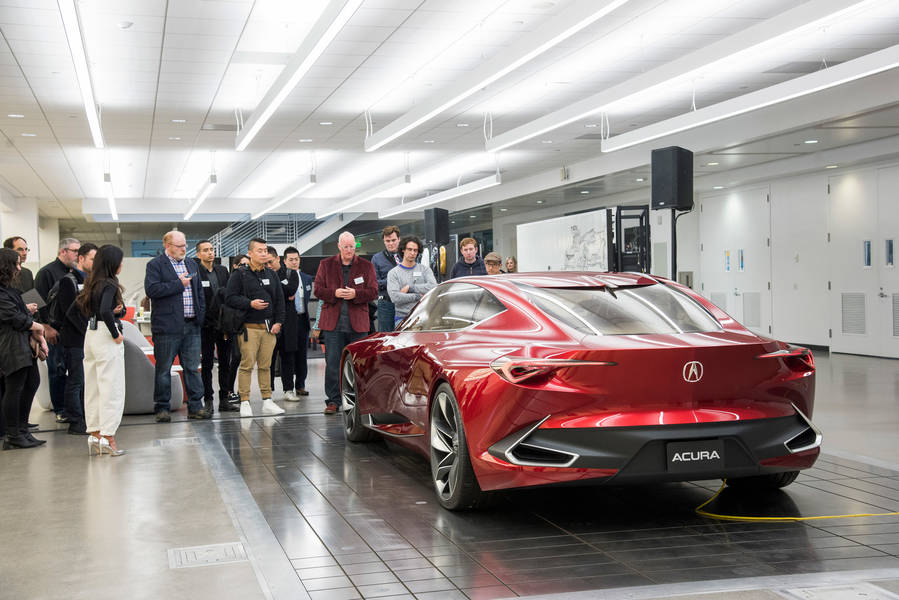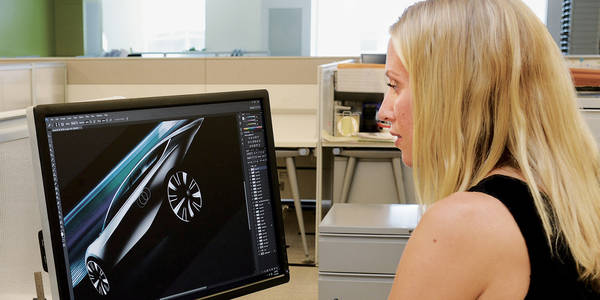
feature / alumni / transportation-design
June 21, 2019
By: Solvej Schou
Extended Family: From ArtCenter to Acura, Dave Marek Brings People Together
When Acura Executive Creative Director Dave Marek (BS 1987 Transportation Design) walks into a room—tall, laughing and with a pointy strip of white hair on his head—he radiates an infectious energy like that of Gene Wilder in Willy Wonka & the Chocolate Factory.
And when that room is the 49,500-square-foot Acura Design Studio at Honda R&D Americas’ campus in Torrance, California—about 20 miles southeast of Los Angeles—Marek is Willy Wonka himself. It’s here that the alumnus and longtime Transportation Design adjunct professor heads a team of designers for Acura, the American performance and luxury brand of Japanese automaker Honda. Marek started here as an exterior designer 32 years ago, just after graduating from ArtCenter. But rather than making Everlasting Gobstoppers or chocolate rivers, Marek and his team of designers are busy creating the future of Acura—a future that revolves around utilizing the five senses to lead to a more joyful vehicle experience.
We’re all in it together. I want everybody to succeed.
Dave MarekAcura Executive Creative Director

On this day in early 2019, following an introduction by alumnus and Acura Vice President and Brand Officer Jon Ikeda (BS 89 Transportation), Marek strolls into the studio and stands in front of a whiteboard, facing a group of journalists. This is the first time in 12 years, since the space opened in 2007, that the company has invited media inside the studio. Its sky-high white and glass walls contain a treasure trove of design concepts, models and high-tech visions. “Every walk of design you can think of originates here, and ArtCenter is where most of our designers come from,” he tells the journalists.
Marek—wearing a burgundy velvet blazer, two-toned shoes and clear-framed square glasses—has a bunny named Waterlily, loves rock ‘n’ roll and is friends with ZZ Top’s Billy Gibbons. He co-hosts the freewheeling travel podcast Man Seeks Adventure with automotive entrepreneur Brad Fanshaw and television personality Heather Storm. He gets three and a half hours of sleep a night (his mind spins with ideas), and he’s in Tokyo twice a month for work. He also designs art and graphics for championship racing teams, including Honda Racing, and he's created vibrant, swooping “paintscapes” on race cars for 45 years.

His team—which Marek calls “a family”—includes two of his former Transportation Design students: Simon Yu (BS 98), Acura’s lead interior designer who was born in South Korea, raised in California, and has been with the company for more than 17 years; and Randall Smock (BS 01), Acura’s lead exterior designer, who has worked at Acura for more than 18 years and teaches ArtCenter Extension (ACX) courses. Marek's friend and former student Michelle Christensen (BS 05), Acura’s former lead principal designer, was the lead exterior designer of the brand’s powerful second-generation NSX supercar. Marek and Ikeda themselves first met as fellow students at ArtCenter three decades ago. Ikeda started working at Acura after graduating from ArtCenter—two years after Marek.
Turning toward the studio’s whiteboard, Marek pulls out a black pen and begins drawing Acura’s arrow-shaped logo and bumper. He adds and erases elements, making the wheels taller, the grille higher, until he’s sketched the brand’s 2019 RDX midsize luxury crossover SUV. Marek has sketched like this for decades, setting the tone of Acura’s range of vehicles, and especially putting his stamp on the brand’s Precision Crafted Performance DNA in the designs of the next-generation NSX and 2019 RDX. “See, touch and experience,” he says about the Japanese principle of sangen shugi, in which employees participate in the production process in person and base decisions on reality versus theory. “That’s the Honda way.”

Marek then leads the journalists on a sweeping tour of the two-story studio, passing his toy car–covered desk upstairs, and winding through a nearby room designed for what the late Honda co-founder Takeo Fujisawa coined waigaya: impromptu meetings in which problems are tackled. Back downstairs, as reporters mill around the studio, Marek hunkers down inside the gleaming, low-slung Precision Concept, which boasts 22-inch wheels and tires. There, in the car’s sleek cocoon of quiet, he becomes introspective and personal. “I’m adopted,” he says, intently. “And I’m searching, maybe not consciously, for inclusion because of that. My personality outside of work and school is the same. I like to bring people in.”
Born and raised in Sacramento, Marek grew up drawing all the time, especially cars. “I was car crazy,” he says, grinning. His father worked as an engineer in printing, and his mother was a housewife, had attended the University of California, Berkeley, and was an active member of the League of Women Voters. “My mom was a force of nature and the smartest person I’ve ever known.” Marek went to California State University, Sacramento and had his sights set on becoming a senator. He worked for the California State Legislature, printing bills overnight.
Yet despite his political ambitions, he still found himself particularly obsessed with racecars, including the 1969 Porshe 917. A visit to ArtCenter in 1984 literally changed his life. “There were tears,” Marek says of his first trip to the College’s Hillside Campus. “I saw the Student Gallery, and I said to myself, ‘What the hell? This is not real.’”
He submitted his portfolio within four days and was accepted into the College. At ArtCenter, he was influenced by his Transportation Design alumni instructors, including now Transportation Design Chair Stewart Reed (BS 69), Graduate Industrial Design Chair Andy Ogden (BS 83), Lloyd Walker (BS 84) and Doug Halbert (BS 78). Walker, Ogden and Halbert all worked at the time at Honda R&D, and it was Halbert who hired Marek.

Marek remembers thinking “I’m home” when he began working at Acura.
The first cars Marek worked on were the 1990 Honda Accord and the first-generation NSX. Still seated in the Precision Concept, he laughs when recalling one of his early contributions to the NSX design. Shortly after starting his new job, Marek was asked to go to Acura’s studio in Japan. While there, he heard his name being broadcast loudly over the intercom. “I go to where the designers are, and there’s a clay model of an NSX seat,” says Marek. “They say, ‘Please sit.’ I sit, and they start measuring. They modeled it around me, since there were no other Americans there. I’m proud of that. I’m proud of my rear.”
Marek spends a lot of time traveling for his job and his podcast. From going to Detroit, Las Vegas, Arizona and beyond for Man Seeks Adventure to his trips to Tokyo for work, he’s racked up more than 2 million airline miles. When home, his routine entails driving 26 miles from his house in Glendale to the Acura Design Studio in Torrance, getting to work around 6:30 a.m. (he uses that early alone time to walk around and study the vehicles). His commute also presents him with an occasional surprise: Once, while stuck in traffic, he spotted presidential candidate and Vermont Senator Bernie Sanders in the vehicle next to him.

His earlier “butt model” story also leads him to a much more serious note about the importance of diversity within transportation design. “I design thinking of the melting pot of people I’ve known my whole life: different cultures, genders and LGBT,” says Marek. “I’ve seen the industry shift and change over the years.”
Marek is proud of his team’s accomplishments as well as his own, including managing the design team of the 2003 Honda Element and 2006 Honda Ridgeline, and the design of the first Acura model to be designed, developed and produced in America: the 1997 Acura CL. He opened Honda’s R&D’s Advanced Design Studio in Pasadena in 2006 and then in 2012 opened its 6,500-square-foot replacement in downtown in L.A., focused on future designers.
“The cliché is, ‘Do something you love, and you’ll never work a day in your life,’” Marek says. “The non-cliché is that I was going to do this anyway. If I had become a senator, I’d probably be grilling somebody while I was sketching a car. I love what I do, and I still kind of think it’s not real.”

Since 1992, Marek has also taught at ArtCenter—first, after graduating, he taught ArtCenter at Night (now ArtCenter Extension) courses and then, later, Transportation Design degree courses, such as the portfolio-building Viscom Fundamentals 7. He views his role as a professor similar to his position at Acura—one of fostering collaboration. “We’re all in it together,” he says. “I want everybody to succeed.”
In the studio, his team demonstrates that collaborative spirit. Smock points to a white full-scale model of the 2019 RDX, whose exterior design he led, and traces its black “dance of lines” stemming from the car’s front logo. Yu shows off the vehicle’s spacious interior, featuring red leather–covered seats and olive ash wood trim, which he describes as “a futuristic vision of a penthouse in the clouds.” Gypsy Modina, color and materials principal designer, and designer Violet Park showcase a table with objects—including metallic baseballs—that inspired the vehicle’s color and materials scheme. Matthew Mantz, a senior clay modeler, displays a quarter-scale model of the car while Shaun Westbrook, a designer and principal lead, presents a look at Acura’s HMI (Human Machine Interface) and its semiautonomous Precision Cockpit.

Wrapping up the presentations, Marek shows a video imagining an autonomous concept car—inspired equally by race cars and the writing of Jules Verne—with a nanocrystal outer skin, AI-powered sensors and an immersive VR cabin.
“We’re always aiming at what the future is,” Marek says, “and how we will get there.”















